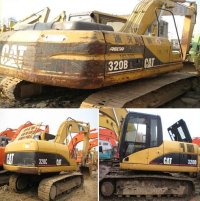Home »
Articles » Buying Used Excavator- Some Tips to Inspect Excavators
Buying Used Excavator- Some Tips to Inspect Excavators
When you decide upon using
excavators, you have multiple options for getting them. You can buy new excavators directly from the excavator manufacturers or you can buy used excavator from an existing user or excavators suppliers who also deal in old excavators. You may even decide upon renting excavators but that's only when you need the excavating machine for a temporary period. If you have to use excavator daily or even occasionally, you must buy one. As there is not much to consider about buying new machines from excavators manufacturers, we give you some tips on buying used excavators in this article.
Here you will get tips about how to decide whether you should buy a new or used excavator? What considerations to be kept in mind when buying it and how to inspect used excavator before buying.
How to Buy Used Excavator- Points to Consider

Used Excavator
You must consider the following points before even deciding whether to buy new or used excavator.
-
Excavators manufactures make these machines with an approximate operating lifespan of 8,000 to 10,000 hours. So, consider buying used excavator of 2-3 years old model with only a few thousand hours on them. They are about 20-25% cheaper than a new excavator.
-
If your budget is lower, you might consider buying used excavator of more than 3 years old model with a concession of about 45-50% of the cost of new machine. However, they will only be useful when you have to work with them occasionally.
How to Inspect Used Excavator?
Although used excavators are cheaper, they might require frequent repairs that could add on their total cost involved. Thus before buying used excavator, inspect its important parts physically as well as by operating it.
-
Excavating Machine Engine- Look for soot (from smoke) which indicates the requirement engine overhauling. You must also check for signs of engine oil leakages or neglect, battery for corrosion, air cleaner system for their proper working, proper cooling system as a damaged one can cause engine overheat.
-
Excavator Body and Interiors- make sure that proper maintenance of cab, stick, boom and bucket has been undertaken. Look for the body of the excavator for any damage. Patches through welding can reflect the extent of repair work already done on the cab. See that nothing is bend underneath the bucket. If so, then it is sure that the excavator had been used for works beyond its capacity.
-
Excavator Tracks & Undercarriage
- Check all the individual metal plates tracks and see if they are broken or have signs of wear and tear. Also check the sprockets and rollers individually. If all of these need replacement then the total cost of used excavator may go higher. Also check the oil level and cleanliness when checking tracks. You must also inspect the roller metal frame of the used excavator to see for signs of crack or repair.
How to Inspect Operation of Used Excavator?
-
Start the excavator engine and ask the seller of used excavator for showing the movement of bucket, stick and boom.
-
In this stage you have to inspect the hydraulic cylinders and tubes as well. See that there are no signs of leakage or scratch on the surface of the cylinder. Cylinders should not be bent or damaged.
-
Pay attention to the tracks performance and see if both tracks are rotating equally.
-
If needed, drive excavator for a short distance to see if it runs straight.
-
You may also tilt the machine with the bucket and time the turnings of the track over a certain time. Do the same with the other track as both must have same amount of rotation.
-
Check the swing system including the gears and bearing. It must rotate the cab with little or no deflection and should stop and start smoothly without any sloppiness or lurching. Check the swing in both clockwise and counter clockwise direction.


